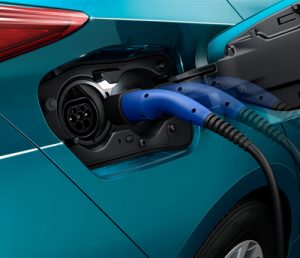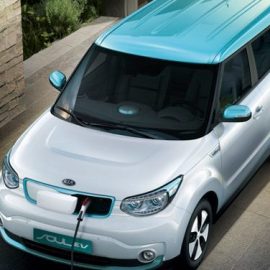Look and Living
 Everyone knows the look of a Prius, otherwise known as the ‘Uber ‘ car. For its fourth incarnation Toyota is offering a Toyota Prius Plug-In Hybrid version as well as the normal engine charged Hybrid.
Everyone knows the look of a Prius, otherwise known as the ‘Uber ‘ car. For its fourth incarnation Toyota is offering a Toyota Prius Plug-In Hybrid version as well as the normal engine charged Hybrid.
The PHEV version is distinguished by its 4 unit LED headlights and a curved rear window and hatch. With a very low drag co-efficient of 0.25 it is very aerodynamic, which leads to, in my opinion, an unattractive car.
Inside the car is similar to previous Prius models, surprisingly the rear bench in the PHEV has been replaced by two seats and a centre armrest. This is surprising as this makes it a 4 seater, having a detrimental effect on its resale value. It will be certainly be less attractive to taxi drivers which keep the second hand market for Prius buoyant.
Instrumentation is covered in a centrally mounted driver information panel on the dashboard and an 8 inch touchscreen in the centre console. There is also a heads-up display showing the driver the car speed and Eco performance. Other buttons and switches are placed below the touch screen and on the steering wheel, overall the instruments and controls are plastic and feel cheap.
The seats are comfortable but lack support, they are manually adjusted, even on the top of the range  models.
models.
The boot space is quite limited as the floor is quite high due to the battery being placed below this between the rear wheels. Unlike pure EVs there is less storage room not more.
6/10
Technology
The PHEV version of the Prius comes loaded with lots of driver aids:
- blind spot monitor.
- adaptive cruise control, keeps the car at a certain distance from the vehicle in front.
- rear cross traffic alert, when reversing will detect a car driving past the back of the car.
- reversing camera.
- simple intelligent parking assist (option) will steer/park the car, driver provides accelerator/brake inputs.
- lane departure alert add steering control, corrective steering will be applied in case of unintentional lane departure.
The car also features a useful head up display and road sign assist which shows the current speed limit and  will emit audio warnings should the driver not be following road sign indications. A wireless phone charging pad is also standard which is great for drivers and passengers who have wireless charging phones.
will emit audio warnings should the driver not be following road sign indications. A wireless phone charging pad is also standard which is great for drivers and passengers who have wireless charging phones.
Toyota makes a great deal about the option of a solar car roof, a feature I have always thought obvious for EVs. This option is only available on the Business Edition Plus Model and not the superior Excel model which is strange. The solar roof ‘helps’  to re-charge the lithium ion battery when parked, but not when plugged in. While driving it adds extra power to electronics such as sat-nav, lights and automatic windows. The reality of solar power is that the output doesn’t generate enough power to make a significant difference, more of a gimmick than a game changer.
to re-charge the lithium ion battery when parked, but not when plugged in. While driving it adds extra power to electronics such as sat-nav, lights and automatic windows. The reality of solar power is that the output doesn’t generate enough power to make a significant difference, more of a gimmick than a game changer.
Although there is lots of clever and useful technology on board, none of it is cutting edge and taking a leap forward in the EV world.
7/10
Performance and Drive
The car has 3 different drive modes;
- EV mode, primarily uses the electric motors, delivering 68 Kw for up to 39 miles.
- HV mode, combines petrol and electric motors.
- EV-city mode, uses electric only, limiting power to 53 Kw.
When the battery drops below a threshold, the car automatically switches to HV mode. The car can also be set to Eco, Normal or Power driving styles.
The car has two electric motors driving the front wheels, positioned behind the petrol engine.
 Driving the car is as easy as driving any other automatic car, choose your mode and put it into drive mode and you are away. In EV mode driving around town the petrol engine will not kick in unless you accelerate quite hard. The car is very quiet if you are not listening to music, you can hear the brakes as you break. Once in petrol engine mode the engine is quiet and intrusive.
Driving the car is as easy as driving any other automatic car, choose your mode and put it into drive mode and you are away. In EV mode driving around town the petrol engine will not kick in unless you accelerate quite hard. The car is very quiet if you are not listening to music, you can hear the brakes as you break. Once in petrol engine mode the engine is quiet and intrusive.
Unlike the pure electric vehicles there is no retardation from automatic breaking, it drives like a regular car. It is not a very exciting car, it is quite quick off the mark but due to the extra weight of the petrol engine it is not nearly as quick as an EV.
The car handles corners easily and rides bumps smoothly. The brakes can be a bit grabby which is nothing new in a hybrid car as it charges the batteries under braking. The weight distribution is higher than an EV as the battery is between the rear wheels, underneath the boot. This gives a fairly 50/50 weight distribution with the engine and motors under the bonnet. But not the very low centre of gravity achieved by the EV cars with their battery packs under the cars floor and between the axles.
By no means a sports car with its soft ride, the car is easy to drive and would suit a family well.
6.5/10
Range, charging and greenness
The Plug-In has a 8.8 Kw battery allowing a maximum electric only range of around 40 miles. Enough for your average daily commutes or shopping/school runs. This is a step up from the non-plug in model and has the potential to run as a pure EV for everything but longer runs. The practicality of the petrol engine then kicks in and the driver does not have the worry of finding suitable charging points on their long range drives.
 Plug in charge times are relatively short due to a smaller (8.8 Kw) battery than pure EVs. A domestic plug charge will only take 3 hours and a 3 Kw charge point only 2 hours. Charging can be set using a timer to make the most of cheap overnight electricity. It can also be set to achieve the internal temperature you prefer prior to starting your journey.
Plug in charge times are relatively short due to a smaller (8.8 Kw) battery than pure EVs. A domestic plug charge will only take 3 hours and a 3 Kw charge point only 2 hours. Charging can be set using a timer to make the most of cheap overnight electricity. It can also be set to achieve the internal temperature you prefer prior to starting your journey.
With official CO2 emissions at 22g/km it is one of the lowest for a hybrid, an improvement on the standard Prius and attract category 2 government grants.
Although the The Toyota Prius Plug-In Hybrid is a step up in the EV world and the Prius is a very successful car for Toyota, it would have been great to see a full EV, the PHEV feels like another compromise rather than leap forward for Toyota.
The car as with all Toyotas has a 5 year/100,000 mile warranty.
6/10
Specification and Extras
The specification on the Business Edition Plus and the Excel are very high with very few options available. There are only 5 body colour options and 2 trim colour options available. This is a strategy from Toyota to keep costs down through easier production and waiting times down as most cars are of the same specification.
Prices start at £32,645 including the government grant.
8/10
Please add your Review and help our community with your valued experience and feedback.
Specification: Toyota Prius Plug-In Hybrid Review
|
User Reviews
Be the first to review “Toyota Prius Plug-In Hybrid Review” Cancel reply
You must be logged in to post a review.
- Extended EV range over normal Prius
- Reliability and running costs
- Up to 800 mile range
- 4 seater could affect resale value
- Small boot
- Plastic finish
- Grabby brakes
- Extended EV range over normal Prius
- Reliability and running costs
- Up to 800 mile range
- 4 seater could affect resale value
- Small boot
- Plastic finish
- Grabby brakes















There are no reviews yet.